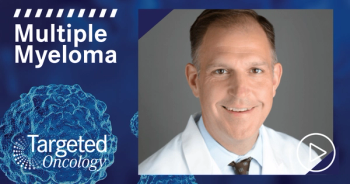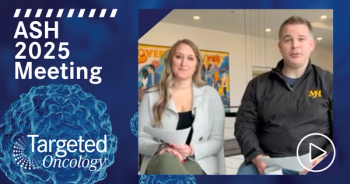
Immunotherapy Combinations Key in Multiple Myeloma
The key to inducing durable responses with immunotherapy in multiple myeloma may depend on the effective use of combination strategies, particularly for the use of monoclonal antibodies.
“In combinations we really do see dramatic increases in efficacy, when lenalidomide and dexamethasone are used in the combinations,” said Smith, a medical oncologist at Memorial Sloan Kettering Cancer Center. “The monotherapy results are somewhat less exciting. Combination therapy are really going to be the key here.”
As single agents, many of the immunotherapies have demonstrated lackluster findings for patients with relapsed multiple myeloma. As a single agent, the antiSLAMF7 agent elotuzumab (Empliciti) failed to elicit responses, though the stable disease rate was 26.5%. Monotherapy with the CD38 antibody daratumumab (Darzalex) fared slightly better, Smith noted, with a single-agent response rate of 36%, which included complete remissions (CRs).
When looking at these antibodies in combination, the results were far more substantial. In the phase III ELOQUENT-2 study, the combination of elotuzumab, lenalidomide (Revlimid), and dexamethasone elicited an objective response rate (ORR) of 78.5% and a median progression-free survival (PFS) of 19.4 months. Similarly, in the phase III POLLUX trial exploring daratumumab, lenalidomide, and dexamethasone, the ORR was 92.9% and the 12-month PFS was 83.2%.
Further immunotherapeutic potential has been realized across various types of cancer by taking the “brakes” off the immune system through the inhibition of various checkpoints, such as PD-1 and CTLA-4. To this end, the PD-1 inhibitor nivolumab (Opdivo) was explored across various hematologic malignancies in an early phase study as a single agent. However, out of 27 patients with multiple myeloma, only 1 responded to single-agent PD-1 inhibition.
In a separate experience using the PD-1 inhibitor pembrolizumab (Keytruda) in combination with lenalidomide and dexamethasone, the results were far more exciting. In this study, the triplet reduced M protein levels in 88% of patients. The ORR in this relapsed/refractory population was 50%, which included 1 CR. Moreover, even those with lenalidomide-refractory disease responded to therapy.
“Even in a lenalidomide refractory population we still see really impressive overall response rates, again, going back to the fact that combination therapies are really working to have the T cells overcome the immune suppression of the myeloma cell microenvironment,” said Smith.
In addition to monoclonal antibodies and checkpoint inhibitors, cellular therapies, such as chimeric antigen receptor (CAR)-modified T cell therapies, are also under exploration. This approach builds upon years of experience with allogeneic stem cell transplantation, said Smith.
The CAR T cell therapies, which have primarily been geared toward CD19, have demonstrated impressive efficacy for patients with B-cell acute lymphoblastic leukemia. These same treatments have been explored in myeloma with intriguing, yet limited, results. In these early studies, the CD19-directed CAR T cell therapies have been utilized.
To build upon these early results, a new target that was more active in myeloma but not heavily expressed in normal cells needed to be identified, since CD19 is not highly expressed in myeloma, noted Smith. In the past year, a new target, B-cell maturation antigen (BCMA), has moved to the forefront of development for its myeloma-specific activity.
In a small study, BCMA-targeted CAR T cell therapy was explored in 12 patients with myeloma following cyclophosphamide and fludarabine preconditioning. Overall, there was 1 stringent CR that lasted for 17 weeks and 1 very good partial response that was still ongoing at 26 weeks.
To-date, the main concerns with this approach has been cytokine release syndrome and neurotoxicity. Treatment algorithms are being put into place to counter these adverse events, Smith noted, primarily the use of IL-6 antibodies. Additionally, the construct of these therapies are evolving, to help ameliorate these events.
“The CAR T cell therapy field is advancing. We're now putting in not only 1 or 2 genes but 3 genes into the cell, that include ways to modify the microenvironment or to secrete cytokines or to express other ligands that might give the cells an advantage,” said Smith.








































